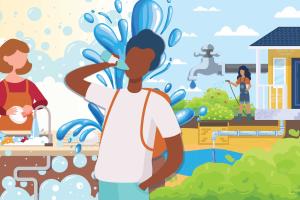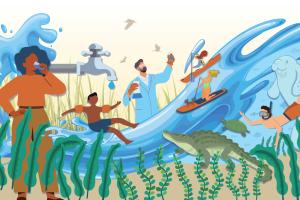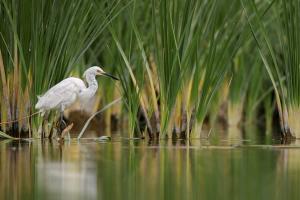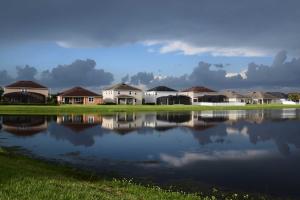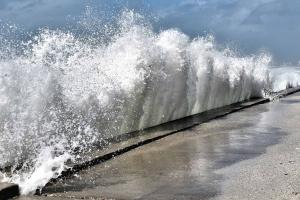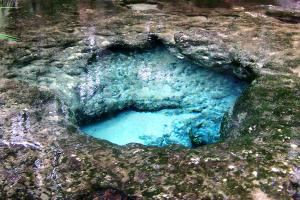Search Content
Displaying results 1781 - 1800 of 4920
The Southwest Florida Water Management District is in the process of developing the 2025 Regional Water Supply Plan (RWSP). The plan lists projected water demands as well as possible water sources for each region of the District through the year 2045. The draft RWSP is posted on the District webpage. Comments may be submitted virtually thought the webpage.…
The Southwest Florida Water Management District is in the process of developing the 2025 Regional Water Supply Plan (RWSP). The plan lists projected water demands as well as possible water sources for each region of the District through the year 2045. The draft RWSP is posted on the District webpage. Comments may be submitted virtually thought the webpage. At the workshop…
The Southwest Florida Water Management District urges year-round water conservation. Water levels may rise and fall, but our water resources remain limited. The District encourages efficient, non-wasteful uses of water to sustain our high quality of life. For more information about ways to conserve water, contact the District at 1-800-423-1476 or visit the District's website.
Each year the District generates population projections for the 16 counties wholly or partially under its jurisdiction.InstructionsSection C-1GIS model population projections by county, utility and public supply service area Section C-2GIS model parcel-level population projectionsThese parcel-level projections, combined with any GIS boundary, can be used to develop population projections for any given area. (All files .zip).•…
Water supply refers to the source and process of providing water to different users. The “source” refers to where the water comes from. Sources of natural fresh water may include groundwater or surface waters, such as lakes, rivers, ponds or streams.
According to the Florida Department of Environmental Protection, surface water was the largest source of fresh water in Florida until 1980. After 1980, groundwater became…
H₂O Zone »
Welcome to the H₂O Zone! To begin your exploration of all things water, click on a topic using the tabs at the top of the page or the links below.Pay special attention to the words in bold on each page for vocabulary. Not sure what something means? Check the word glossary.Water Basics
In the Bathroom:
- Flush less — remember the toilet is not an ashtray or wastebasket.
- While brushing teeth, shaving, etc., turn off the water.
- When cold water will do, avoid using hot water.
- Take shorter showers — 5 minutes or less.
- In the shower, wet yourself down, turn the water off, lather up, then turn the water on to rinse off soap.
- Use less water for bathing — close the drain first and fill tub only one…
Word Glossary
Alternative Water Supply (AWS)
Includes the use of a nontraditional source of water to help meet different freshwater needs of a community. Examples include reusing wastewater or treating seawater through a desalination plant.
Aquifer
An aquifer is an area underground that holds water in the gaps between rock, sand or gravel, sort of like an underground lake or stream.
Compost…
We All Live in a Watershed
Land is very important to the water cycle and shares a strong connection to our water resources. Did you know that everything we do on land can affect the health of our water? That is because we all live in a watershed!
A watershed is any area of land that water flows across or through. Where is the water going? Downhill of course. Water in a watershed trickles and flows toward a common body of…
Water Use Permit Bureau ChiefAs bureau chief of the Water Use Permit Program, April is responsible for overseeing water use permit evaluation, water use permit compliance, well construction permitting and demand management.April has 15 years of experience related to challenging water use permitting considerations. She previously held various significant roles with the District, including Water Use Evaluation and Compliance manager and hydrogeologist.April earned a bachelor’s…
The Green Swamp is recognized by the state of Florida for its ecological and hydrological importance. There are several unique characteristics of the area. The Green Swamp can store surface water and slow the flow of floodwaters while sustaining rivers and streams. Its relatively high elevation, together with a shallow depth to the aquifer, keeps water levels high. The water table for much of the year stands above the potentiometric surface of the Floridan aquifer, providing…
In recent years the number of people living in the Alafia River watershed has increased dramatically. An increase in population causes a greater demand on water resources and a reduction in the amount of wildlife habitat. Efforts have been made to meet the increased demands for water and to restore and protect natural ecosystems within the watershed.
Reservoir
The C.W. “Bill” Young Regional Reservoir is located in the Alafia River watershed. It can store 15 billion…
The word “resiliency” can be described as the ability to recover quickly from disasters and adapt to future conditions. The word also refers to building defenses against the impacts of climate change. Coastal Florida is vulnerable to impacts from climate change, which may include temperature extremes, intensified storms, increased flooding and sea level rise. West-central Florida has already seen some of these adverse impacts, and projections show the impacts will…
Joint Public Workshop on the 2025 Priority Lists and Schedules for the Central Florida Water Initiative (CFWI) Planning Area: South Florida Water Management District, Southwest Florida Water Management District and St. Johns River Water Management District
- …
What are MFLs?“MFLs” is short for minimum flows and minimum water levels. Minimum flows are set for rivers, streams, estuaries, and springs, while minimum water levels are established for lakes, wetlands, and aquifers. In short, an MFL sets a limit on how much water can be withdrawn from a water resource to prevent significant harm occurring to the water resources or the ecology of the area.Why does the Southwest Florida Water Management District set MFLs?Florida law (…
What springs are located within our District? There are more than 200 springs within the District. There are five first-magnitude spring groups in the District. First-magnitude springs, which are the largest springs by volume of water discharged, release 64.6 million gallons per day or more. The five springs are: Rainbow River, Crystal River/Kings Bay, Homosassa River, Chassahowitzka River and Weeki Wachee River. Together, they discharge more than one…


